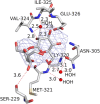The TrmB family: a versatile group of transcriptional regulators in Archaea
- PMID: 25116054
- PMCID: PMC4158304
- DOI: 10.1007/s00792-014-0677-2
The TrmB family: a versatile group of transcriptional regulators in Archaea
Abstract
Microbes are organisms which are well adapted to their habitat. Their survival depends on the regulation of gene expression levels in response to environmental signals. The most important step in regulation of gene expression takes place at the transcriptional level. This regulation is intriguing in Archaea because the eu-karyotic-like transcription apparatus is modulated by bacterial-like transcription regulators. The transcriptional regulator of mal operon (TrmB) family is well known as a very large group of regulators in Archaea with more than 250 members to date. One special feature of these regulators is that some of them can act as repressor, some as activator and others as both repressor and activator. This review gives a short updated overview of the TrmB family and their regulatory patterns in different Archaea as a lot of new data have been published on this topic since the last review from 2008.
Figures








Similar articles
-
Global transcriptional regulator TrmB family members in prokaryotes.J Microbiol. 2016 Oct;54(10):639-45. doi: 10.1007/s12275-016-6362-7. Epub 2016 Sep 30. J Microbiol. 2016. PMID: 27687225 Review.
-
TrmB Family Transcription Factor as a Thiol-Based Regulator of Oxidative Stress Response.mBio. 2022 Aug 30;13(4):e0063322. doi: 10.1128/mbio.00633-22. Epub 2022 Jul 20. mBio. 2022. PMID: 35856564 Free PMC article.
-
The role of TrmB and TrmB-like transcriptional regulators for sugar transport and metabolism in the hyperthermophilic archaeon Pyrococcus furiosus.Arch Microbiol. 2008 Sep;190(3):247-56. doi: 10.1007/s00203-008-0378-2. Epub 2008 May 11. Arch Microbiol. 2008. PMID: 18470695 Review.
-
TrmB, a sugar sensing regulator of ABC transporter genes in Pyrococcus furiosus exhibits dual promoter specificity and is controlled by different inducers.Mol Microbiol. 2005 Sep;57(6):1797-807. doi: 10.1111/j.1365-2958.2005.04804.x. Mol Microbiol. 2005. PMID: 16135241
-
Common history at the origin of the position-function correlation in transcriptional regulators in archaea and bacteria.J Mol Evol. 2001 Sep;53(3):172-9. doi: 10.1007/s002390010207. J Mol Evol. 2001. PMID: 11523004
Cited by
-
Gene regulation of two ferredoxin:NADP+ oxidoreductases by the redox-responsive regulator SurR in Thermococcus kodakarensis.Extremophiles. 2017 Sep;21(5):903-917. doi: 10.1007/s00792-017-0952-0. Epub 2017 Jul 7. Extremophiles. 2017. PMID: 28688056
-
Phyletic Distribution and Lineage-Specific Domain Architectures of Archaeal Two-Component Signal Transduction Systems.J Bacteriol. 2018 Mar 12;200(7):e00681-17. doi: 10.1128/JB.00681-17. Print 2018 Apr 1. J Bacteriol. 2018. PMID: 29263101 Free PMC article.
-
Different Proteins Mediate Step-Wise Chromosome Architectures in Thermoplasma acidophilum and Pyrobaculum calidifontis.Front Microbiol. 2020 Jun 12;11:1247. doi: 10.3389/fmicb.2020.01247. eCollection 2020. Front Microbiol. 2020. PMID: 32655523 Free PMC article.
-
Genome-wide binding analysis of the transcriptional regulator TrmBL1 in Pyrococcus furiosus.BMC Genomics. 2016 Jan 8;17:40. doi: 10.1186/s12864-015-2360-0. BMC Genomics. 2016. PMID: 26747700 Free PMC article.
-
The Piezo-Hyperthermophilic Archaeon Thermococcus piezophilus Regulates Its Energy Efficiency System to Cope With Large Hydrostatic Pressure Variations.Front Microbiol. 2021 Nov 3;12:730231. doi: 10.3389/fmicb.2021.730231. eCollection 2021. Front Microbiol. 2021. PMID: 34803948 Free PMC article.
References
Publication types
MeSH terms
Substances
LinkOut - more resources
Full Text Sources
Other Literature Sources
Research Materials

